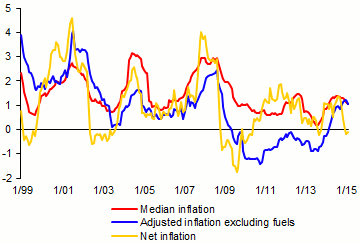Median inflation
In addition to the official Czech inflation indicators published by the CZSO, alternative measures of inflation are constructed at the CNB for the purposes of assessing domestic price developments. These measures are aimed at filtering out one-off, temporary (and usually exogenous) effects and thereby obtaining indicators that only reflect fundamental domestic inflation factors. Such indicators gain in importance at times when headline inflation is affected by strong external shocks (such as the recent sharp fall in world crude oil prices). One such indicator is median inflation.
Classically calculated inflation indicators – both the official ones published by the CZSO and the alternative ones constructed at the CNB – use the weighted arithmetic mean to measure the average change in prices. However, the arithmetic mean is highly sensitive to extreme price movements. In the calculation of the various measures of core inflation, therefore, items that are most affected by transitory external shocks are usually omitted. These are typically food items, whose prices are subject to weather- and harvest-dependent volatility, and energy and fuels, whose prices are derived from global oil prices. Administered price items are also excluded, and the remaining items are adjusted for changes to excise duties and VAT (e.g. adjusted inflation excluding fuels).
Median inflation uses the same weighting scheme and the same time series for the price indices of consumer basket items as the classically calculated inflation indicators. In this case, however, only administered price items are systematically excluded from the calculation. The remaining items are then adjusted for changes to VAT. The calculation is conducted on a month-on-month basis, so seasonal adjustment is also necessary. The weighted median is then used to estimate average inflation. The month-on-month price changes of the individual items in the given month are ordered from the largest to smallest and their weight is progressively summed. The inflation rate of the item located closest to the accumulated weight of 0.5 is denoted the median inflation rate. Annual inflation is then obtained by chaining the month-on-month figures.
Median-based core inflation is significantly smoother than classical core inflation aggregates based on the weighted arithmetic mean (see Chart 1). Median inflation thus provides a useful analytical picture of price developments in the core consumer basket, especially at times when headline inflation is being affected by strong exogenous shocks. In 2009–2011, for example, the classical core inflation indicators were pushed down to very low and later even negative values as a result of sharp declines in the prices of only a few consumer basket items, while the median inflation rate stayed positive in the same period. During the 2012–2013 recession, however, the median inflation rate fell to a historical low in September 2013 (0.2%) and threatened to sink into the deflation band for the first time ever. After the CNB weakened the exchange rate in November 2013, however, the annual median inflation rate started to go up smoothly, reaching 1.3% at the end of 2014.
Chart 1 (BOX) Comparison of median inflation with classical inflation indicators
Median inflation is significantly smoother than classical indicators. It has increased since autumn 2013 and currently stands at 1%
(annual percentage changes; source: CZSO; CNB calculation)

So far this year, the median inflation rate has decreased slightly as the direct effect of the weakening of the koruna has gradually dropped out of it. However, it remains noticeably positive (1.0% in March 2015), as – by construction – it has not been significantly affected by the drop in oil prices or by the fall in food prices, which are dragging headline inflation down to near-zero levels (and inflation net of tax changes temporarily into negative territory). It thus probably most strongly reflects the modest inflationary effect of the renewed growth in the domestic economy and the generally accommodative monetary conditions seen over the last few quarters.
